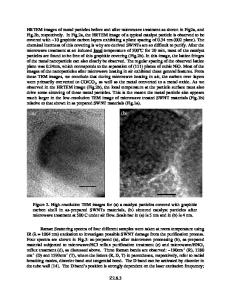Microwave heating of ceramics and its application to joining
- PDF / 4,217,383 Bytes
- 9 Pages / 593.28 x 841.68 pts Page_size
- 23 Downloads / 297 Views
. INTRODUCTION
Fine ceramics, which are excellent in resistance to heat and corrosion, are promising as structural materials capable of replacing metals under high-temperature use. However, ceramics are very difficult to machine. This is the main impediment to the wider utilization of ceramics. One solution is to develop techniques for fabricating a complexly shaped article from small parts by joining. In conventional joining methods, the joining strength is not sufficient at high temperatures and the energy efficiency is low because of the use of external heating. To overcome these defects, the sintering or joining of ceramics by microwave heating has been studied.1"4 We also have been developing the technique of microwave heating and joining.5 Generally, it has been considered difficult to heat ceramics by microwave energy because ceramics have a small dielectric loss factor. However, as shown in Fig. 1, the authors have found that the loss factor of ceramics rapidly increases with the temperature rise and the value at 1800 °C is two orders of magnitude larger than that at room temperature.6 The result proves that rapid and high-temperature heating is possible by microwave radiation even in ceramics having a low loss factor in the microwave region. As a result, ceramics can be joined together. This joining method is applicable not only to round bars but also to various shapes such as pipes, square bars, and different sized bars.5 Microwave joining has advantages such as high joint strengths, and rapid and local heating under precise temperature control. This paper describes the microwave heating control system developed to join ceramics, the possibility of J. Mater. Res., Vol. 5, No. 2, Feb 1990
ceramic-ceramic joining with or without the intermediate by using this system, and the results of examination of the microstructure and properties of the joined area. II. HEATING CONTROL SYSTEM
Figure 2 shows the control system for microwave heating and joining. This system is comprised of a microwave oscillator with 6 GHz band, a klystron capable of amplifying the microwave power up to 3 kW, a cavity
1000
2000
Temperature (°C) FIG. 1. Temperature dependence of dielectric loss factor of 92% purity alumina measured at 6 GHz. © 1990 Materials Research Society
397
H. Fukushima, T. Yamanaka, and M. Matsui: Microwave heating of ceramics
Pyrometer Attenuator
Waveguide
FIG. 2. Control system for microwave heating or joining.
for heating or joining ceramics, a directional coupler for detecting the power reflected from the cavity, and a pyrometer for measuring the temperature of the joining surface of ceramics. The temperature of the pyrometer was calibrated by a Pt-Rh thermocouple. A single mode rectangular cavity as shown in Fig. 3 was used for microwave heating or joining. The cavity resonates in the TE103 mode. The joining surface of ceramic rods is located in the maximum electric field strength zone of the cavity. The joining of ceramics was then carried out by applying an axial compressive load to the end of each
Data Loading...










